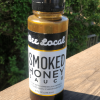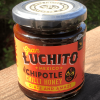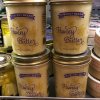
On a whim, my family started keeping bees in my backyard this season. After listening to a few people speak enthusiastically about beekeeping, I decided to take the plunge. We bought a Longstroth Hive (simple pine box with 10 vertical frames) and a Bee Package to populate the hive. The packet consisted of 1 queen, and about 10k worker bees and a few drones. We placed the hive in the sunny corner of our small yard, and in a matter of weeks, the hive seemed to be thriving. During the heat of the summer day, the bees were coming and going through the single opening at the base like it was Grand Central Station at 5 pm. We told a few of our neighbors about the hive and most were excited and curious, while a few expressed concerns because they thought the bees might sting their children. After opening the hive a few times to inspect it and becoming more confident and less scared about handling the hive, we added a second module or box so the colony could spread out. Beekeepers never talk about honeybees being aggressive but instead talk about some breeds of bees being more defensive than others. After all, we are invading their home when we inspect the hive and bees decide to sting to protect their turf. Fortunately, our bees are not overly defensive of their hive. During the day when we open the hive, the bees seem too busy doing their thing and not excessively concerned with a few humans looking at them. I was only stung once on my hand while trying to photograph the bees with my iPhone.
While hosting the bees in our backyard, we learned a great deal about honeybees and how their colony operates. The colony is really like a self-contained and self-supporting community. The bees or citizens of the colony have many different roles, such as all-important queen, worker bees, drones, nursery workers, and the security detail to guard the hive entrance. The inner workings of the hive is a fascinating subject that once you start learning about it, there is always more to learn and appreciate. And beekeepers all seem eager to share their experiences and provide advice to novices. All the foraging work is done by the worker bees who may fly up to 6 miles from the colony each day in search of flower nectar and pollen. The nectar is turned into honey in a specialized stomach, in which the complex carbohydrates of the nectar are broken down by enzymes into simple sugars. The workers then regurgitate the honey into the comb. The honey and pollen are stored in the hive and used for a food source for the young bees, as well as nourishment so the colony can survive the winter. The typical worker bee lives 5 to 6 weeks, forages for 500 miles and produces less than 1 teaspoon of honey. They die when their wings wear out, so the lifespan is a function of how far they have to travel each day in search of nectar and pollen. A hive with 50,0000 worker bees can produce 20-60 pounds of honey per year. From our colony, we are hoping to harvest about 2 quarts of honey (2 frames) and leave most of it in the hive so the bees can survive the winter.
Honey is the ultimate terroir food, as the taste of the honey is almost totally dependent on the local flowers that the bees choose to be the source of their nectar. We have harvested about 1 quart of honey from our hive and we were very pleasantly surprised with its taste. We have tasted other local honey and found the flavors to be different from the honey we harvested. In areas where there are many flowering plants, one colony may choose one type of flower, while a neighboring hive might choose a different plant, and as result, the honey produced in each hive will have its own unique taste. Similarly to wine, commercial honey producers often mix honey from various sources to get a pleasing and consistent flavor.
In our store in Chelsea Market, we stock honey from many different geographies and flavor profiles. Our honey comes from places like New York, England, Mexico, and New Zealand. From England, we import Hilltop Acacia Honey. We also have some artisan products in which honey is flavored with another ingredient. Some of the notable products in this category are Truffle Honey by the Truffieist which is New York State wildflower honey mixed with black truffle, Smoked Honey Sauce by Bee Local from Portland, Oregon, and Gran Luchito Chilli Honey made in Mexico from blended honey flavored with smoked Pasilla Oaxaca Chilli.
If you are interested in learning more about honey we will be having a discussion and tasting of honey in our store on the evening of October 24th. The discussion will be led by Ruth Harrigan, A NYC Beekeeper – and the entrepreneur who started Honeygramz.com. Registration is required and there are limited spaces available. The event will start at 6 pm and involve tasting various honey that we stock in our store. The cost of attendance is $25 plus you will leave with a parting gift of honey samples. Please call/email the store to reserve your spot. There are plenty of online resources about honey production and honeybees. If you are interested in learning more about the honey business and the challenges it faces in the United States, check out Netflix Rotten Docuseries, S1 E1: Lawyers, Guns & Honey (https://www.netflix.com/title/80146284).
While our adventure with our bees has been a fun learning experience, it has also made us aware of just how miraculous nature can be. The importance of bees in our ecosystem has been in the news lately as the bees play an important role in pollinating plants that are used for food production, and the bee populations in North America are dwindling. While our little hive is not going to save the bees, it has made us more aware and curious about how nature works, while filling our pantry with a few jars of delicious honey. It has also given us an appreciation for the serious beekeepers and honey producers and how their business faces many challenges while being important to our collective ecosystem and food production industry. So, if you are thinking about hosting a hive in your backyard, my advice is to go for it!











 Growing up I enjoyed going to both specialty food stores and bookstores, both endangered species now. Like many specialty food retailers, our store shelves includes some notable books. We like Chelsea Market Baskets to be a place of discovery where you find things that you didn’t know you were looking for and wouldn’t find elsewhere. When we buy books for the store we tend to look for new books that have some reference to New York and food. We also think that books about food make wonderful gifts. The three books below are currently on our shelves and I wanted to share why we think each is special:
Growing up I enjoyed going to both specialty food stores and bookstores, both endangered species now. Like many specialty food retailers, our store shelves includes some notable books. We like Chelsea Market Baskets to be a place of discovery where you find things that you didn’t know you were looking for and wouldn’t find elsewhere. When we buy books for the store we tend to look for new books that have some reference to New York and food. We also think that books about food make wonderful gifts. The three books below are currently on our shelves and I wanted to share why we think each is special:

